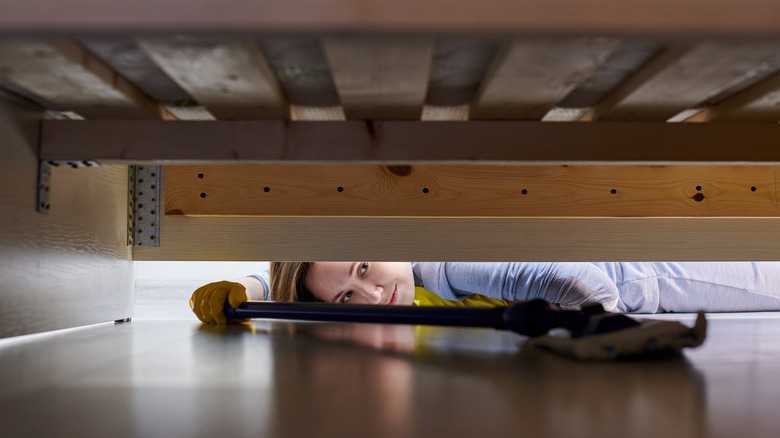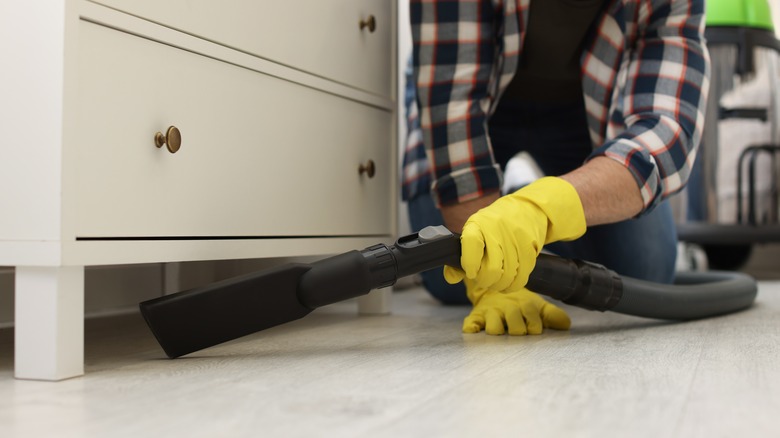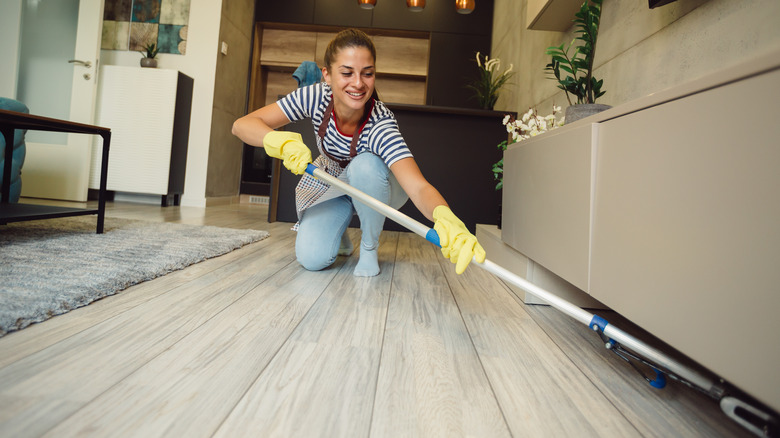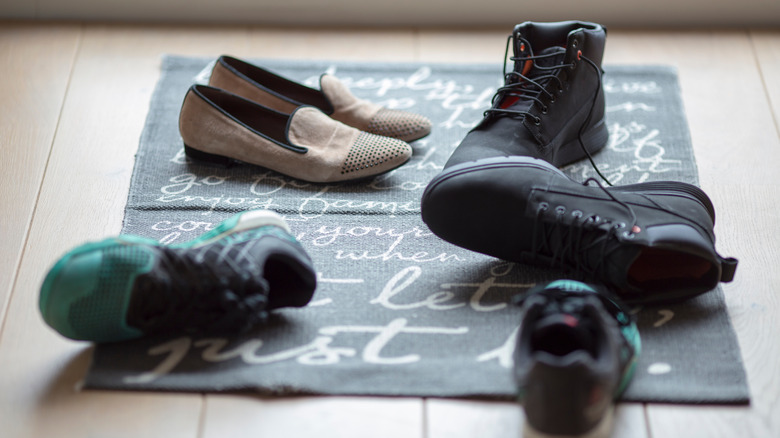The Spot In Your Living Room You're Probably Not Dusting Enough
Dust is an inherent and expected reality of any home, and where there is surface area, so too is the potential for dust (and lots of it if you aren't proactive with the right tools). If you tend to go longer than you should without vacuuming, or only tackle dust in areas that are obvious and visible, it's likely your home is host to it's fair share of dust bunnies — even if you have to get on your hands and knees and look under the furniture to see them.
If you regularly only vacuum the floor around your furniture, and only dust the top of each piece without addressing the underside, you are missing the actual bulk of the dust and allergens, which often hide out of plain sight. The reality is that if you aren't vacuuming and dusting underneath each piece of furniture every time you clean — both the floor beneath the furniture and the underside of the furniture itself — the dust you are seeing and eliminating is only the tip of the iceberg.
Therefore, if your home looks spotless to visitors, but you are guilty of skipping sucking up the dust bunnies beneath your bed and dresser, your home may not be as clean as you or your guests think. As a result, you may be creating a breeding ground for nasty pests, while also exposing you and your household to allergens and harmful concentrations of dust. All of this can affect your overall health and deteriorate the air quality in your home.
The importance of dusting beneath furniture
Not only can dust on the underside of your furniture be unsightly and embarrassing, but an accumulation of it in your home can have serious adverse health effects, such as asthma attacks, allergic reactions, respiratory distress, and even lead poisoning (if the dust comes from a part of your home that contains lead paint). In fact, frequent and excessive inhalation of dust is linked to an increased risk of dying from health complications, such as heart disease, lung cancer, stroke, chronic obstructive pulmonary disease, and lower respiratory infections.
In addition to being bad for your respiratory and overall health, excessive dust in your home can be extremely bad for your HVAC system. On a daily basis, especially as you run your heat or air conditioner, any dust in your environment — either in the air or on the floor beneath furniture or near air vents — gets cycled through the HVAC system. While much of this dust manages to successfully get caught in your system's air filters, some of it also gets stuck in the ductwork of your home itself. When too much dust accumulates in your air ducts, your air conditioner and furnace have to work overtime to push and circulate the air properly. This is hard on the HVAC system and can shorten its lifespan. Plus, your HVAC system circulating dirt and dust back through the house and making it airborne puts you at a greater risk of respiratory illness and health issues.
The best methods for reaching the dust beneath your furniture
As frequently as you are vacuuming the floors around your furniture, you should also be vacuuming beneath it, as well as tackling any dust on the underside of each piece. As tempting as it may be to skip cleaning the underside of your furniture, each time you do so, you are allowing large amounts of dust, dander, and pet hair to accumulate. When you do finally properly clean beneath your furniture, you may be surprised at the size of the dust bunnies and the amount of filth that has built up on the bottom of each piece, as well as the floor beneath it.
With that being said, the easiest way to clean the underside of your furniture is to flip it over or onto its side so you can clearly see what you are doing and reach the entire underside, as well as all areas of the floor underneath the piece. If the furniture is too heavy or unrealistic to move every time you vacuum, your best bet is to utilize a handheld vacuum or the handheld feature on your standing vacuum cleaner. A Swiffer duster or equivalent can also be used to access hard to reach areas of the floor and underside of larger furniture pieces.
Other ways to reduce dust in your house
On top of regularly dusting the underside of your furniture and the area beneath it, there are other precautions and measures you can take to prevent dust from forming in your house. Because approximately 2/3 of all household dust originates from outdoors, the easiest and often most effective solution is to simply make an increased effort to rid yourself of dust and dirt before entering the house. If you don't already, start encouraging your guests to remove their shoes prior to entering your house and do so yourself. This can help you and your family stay healthy, and prevent you from having to do more vacuuming and dusting than you need to.
Remembering to regularly change the air filters in your furnace can also help minimize the dust and airborne particulates that are circulating your home every time you turn on the heat or A/C. Additionally, the quality of the vacuum you use can make a big difference as well. Invest in a vacuum cleaner with a high efficiency particulate air (HEPA) filter, as these are most guaranteed to tackle the harmful levels of dust in your home. Also, keep in mind that carpets trap more dust than hard floors.



